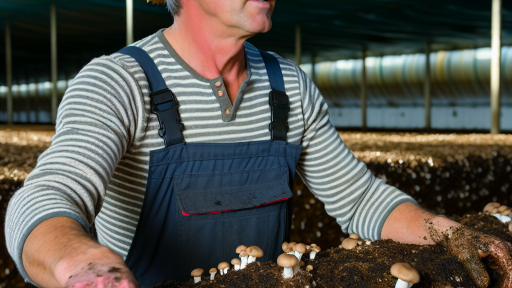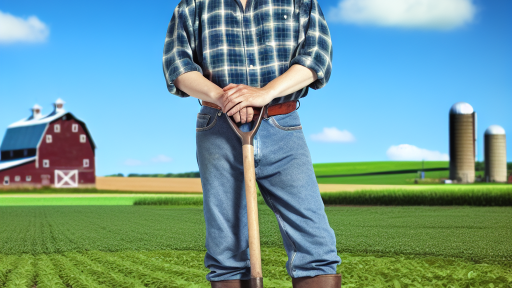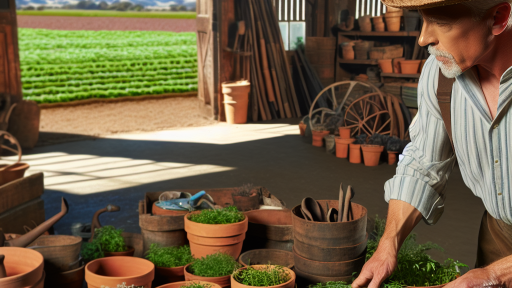Understanding Mushroom Growth Cycles Throughout the Year
Spring Growth Patterns
In spring, temperatures begin to rise, promoting mushroom growth.
Species like oyster mushrooms thrive in this season.
Proper ventilation in growing areas encourages healthy development.
Maintain moisture levels to facilitate rapid growth during spring.
Summer Care Techniques
Summer heat presents challenges for mushroom cultivation.
Monitor humidity closely to prevent drying out substrates.
Shade your growing areas to protect mushrooms from direct sunlight.
Regular misting helps maintain optimal moisture levels in summer.
Autumn Harvest Strategies
Autumn provides ideal conditions for many mushroom varieties.
Start gearing up for harvesting as temperatures stabilize.
Increase nutrient influx to substrates to enhance yield.
Store harvested mushrooms properly to maintain freshness.
Winter Cultivation Considerations
Winter poses unique challenges for mushroom growers.
Indoor environments are crucial for winter cultivation success.
Ensure heating systems maintain consistent temperatures.
Transform Your Agribusiness
Unlock your farm's potential with expert advice tailored to your needs. Get actionable steps that drive real results.
Get StartedUtilize insulation to protect growing conditions from cold drafts.
Year-Round Best Practices
Regardless of the season, cleanliness is vital in mushroom cultivation.
Regularly sanitize tools and equipment to avoid contamination.
Keep accurate records of growth conditions and yields.
Adjust growing techniques based on seasonal observations.
Winter Preparations: Insulating and Heating Your Grow Area
Importance of Insulation
Insulation is crucial for maintaining an optimal temperature in your grow area.
It helps to protect your mushrooms from extreme winter conditions.
Moreover, proper insulation reduces energy costs for heating.
Types of Insulation Materials
There are several effective insulation materials available.
- Fiberglass is popular for its high thermal resistance.
- Foam board adds excellent insulation with ease of installation.
- Spray foam provides an airtight seal to eliminate drafts.
Choosing the right material depends on your specific needs and budget.
Implementing Insulation Techniques
Start by insulating walls to prevent heat loss effectively.
Also, ensure that ceilings are insulated properly to maintain warmth.
Additionally, don’t forget about floors, which can be a significant source of heat loss.
Heating Options for Your Grow Area
A variety of heating solutions are available for mushroom cultivation.
Electric heaters are easy to use and can quickly raise temperatures.
Hydronic heating systems circulate warm water through pipes for even heat distribution.
Consider using infrared heaters for targeted warmth to your mushroom blocks.
Temperature Monitoring
Regularly monitor the temperature in your grow area.
Thermometers with alerts can notify you of temperature fluctuations.
This proactive approach helps prevent damage to your mushrooms.
Energy Efficiency Considerations
Look for energy-efficient heating solutions to reduce costs.
Proper insulation will complement your heating efforts.
Utilizing timers can manage heating schedules effectively.
Spring Strategies: Optimizing Moisture and Nutrient Levels
Understanding Moisture Requirements
Moisture is crucial for mushroom growth.
Showcase Your Farming Business
Publish your professional farming services profile on our blog for a one-time fee of $200 and reach a dedicated audience of farmers and agribusiness owners.
Publish Your ProfileThe ideal humidity level is around 80-90%.
Use a hygrometer to monitor moisture levels.
Regular misting can help maintain appropriate humidity.
Additionally, consider placing trays in shallow water.
This method keeps the substrate adequately moist.
Nutrient Management
Mushrooms require a well-balanced diet.
Start with nutrient-rich substrates like straw or sawdust.
Enrich substrates with nitrogen sources, such as cornmeal.
Consider adding minerals like gypsum for enhanced growth.
Conduct soil tests to determine nutrient deficiencies.
Watering Techniques
Watering mushrooms requires careful attention.
Use a fine mist nozzle to avoid over-saturation.
Water in the morning to reduce evaporation losses.
Observe your crops regularly for moisture needs.
Adjust your watering schedule based on weather conditions.
Utilizing Natural Rainwater
Harvesting rainwater promotes sustainability.
Install rain barrels to collect precipitation.
This water often contains fewer chemicals than tap water.
Use rainwater for misting and watering effectively.
It also helps lower your overall water costs.
Adjusting for Temperature Changes
Temperature fluctuations affect moisture retention.
During warm days, check moisture levels more frequently.
Use shade cloths to regulate greenhouse temperatures.
This technique reduces evaporation rates.
Monitor nighttime temperatures to prevent excess moisture loss.
Discover More: Growing Vegetables In Urban Environments
Summer Challenges: Managing Temperature and Humidity for Optimal Growth
Understanding the Importance of Climate Control
Temperature and humidity directly affect mushroom growth.
Maintaining optimal conditions leads to healthy yields.
Heat stresses mushrooms and can hinder their development.
Humidity levels impact fruiting body formation.
Both factors play crucial roles in cultivation success.
Optimal Temperature Ranges
Mushrooms thrive within specific temperature ranges.
For most varieties, daytime temperatures should stay between 70°F to 75°F.
Nighttime temperatures should cool down to about 60°F to 65°F.
Exceeding these limits can stunt growth or kill the culture.
Regular monitoring ensures temperatures remain consistent.
Controlling Humidity
Humidity influences mushroom texture and size.
A relative humidity of 80% to 90% is ideal for fruiting.
Use a hygrometer to measure humidity accurately.
Should humidity drop, consider misting the growing area.
Showcase Your Farming Business
Publish your professional farming services profile on our blog for a one-time fee of $200 and reach a dedicated audience of farmers and agribusiness owners.
Publish Your ProfileEvaporative coolers can help maintain appropriate moisture levels.
Ventilation and Airflow
Proper airflow reduces the risk of contamination.
Good ventilation enhances gas exchange in the growing environment.
Implement fans to circulate air effectively.
Fresh air intake prevents carbon dioxide buildup.
Adjust ventilation according to temperature and humidity readings.
Monitoring Seasonal Changes
Seasonal shifts can lead to fluctuating temperatures.
Be prepared to modify your setup as summer approaches.
Use insulating materials for your growing space.
This can help maintain stable conditions even in extreme heat.
Keep a close eye on weather forecasts and adjust proactively.
Find Out More: Benefits of Organic Farming for the Environment
Fall Harvesting Techniques
Timing Your Harvest
Timing plays a crucial role in successful mushroom harvesting.
Observe the weather and temperature closely as fall approaches.
Check your mushroom species for optimal harvesting windows.
Generally, warmer autumn days create ideal conditions for growth.
Identifying the Right Harvesting Time
Mushroom caps typically indicate their readiness for harvest.
Look for slightly opened caps that expose the gills beneath.
Avoid harvesting mushrooms that are too mature.
Overripe mushrooms can spoil quickly and affect quality.
Best Practices for Harvesting
Use a sharp knife to cut mushrooms at the base.
A cutting technique minimizes damage to the mycelium underneath.
Place the harvested mushrooms in a breathable container.
This helps maintain their freshness and prevents spoilage.
Post-Harvest Care
After harvesting, clean the mushrooms delicately.
Remove any dirt gently using a soft brush.
Avoid washing them with water, as they absorb moisture easily.
Store harvested mushrooms in a cool, dark place.
Preparing for Next Season
After the harvest, consider soil amendment practices.
This way, you enhance the nutritional quality for future grows.
Apply organic compost to improve soil structure and nutrients.
Plan your next crop cycle based on harvest results.
Find Out More: Perennial Vegetables for Edible Landscapes

Seasonal Pest and Disease Management Tips
Spring Strategies
Spring marks a critical time for mushroom growers.
Start by inspecting your growing area for potential pests.
Caterpillars and aphids often emerge during this season.
Use organic pest control methods to manage outbreaks.
Moreover, ensure proper air circulation to prevent fungal diseases.
Summer Precautions
Summer heat can stress mushroom crops significantly.
Monitor moisture levels closely to avoid dehydration.
Showcase Your Farming Business
Publish your professional farming services profile on our blog for a one-time fee of $200 and reach a dedicated audience of farmers and agribusiness owners.
Publish Your ProfileAdditionally, keep an eye out for mold growth in warm temperatures.
Introduce beneficial insects, such as ladybugs, to control aphids.
Regularly check for signs of any disease and act quickly.
Autumn Approaches
As temperatures drop, prepare for new pest challenges.
Slugs and snails can become problematic during this season.
Use barriers like copper tape to deter these pests.
Also, maintain hygiene by removing any decaying matter.
This helps reduce fungal spores from taking hold.
Winter Maintenance
In winter, ensure your growing environment remains stable.
Monitor humidity and temperature fluctuations carefully.
Pests can still be present, so regular inspections are essential.
Use greenhouse heaters to maintain a consistent climate.
Finally, review your pest management strategies as the season changes.
Gain More Insights: Setting Up A Sustainable Container Farm
Choosing the Right Mushroom Varieties for Each Season
Understanding Seasonal Conditions
Different seasons bring unique climate challenges.
Mushrooms thrive under specific temperature and humidity levels.
Understanding these conditions helps in selecting varieties.
Seasonal changes can affect both indoor and outdoor cultivation.
Spring Mushroom Varieties
Spring is an ideal time for certain mushroom types.
Oyster mushrooms flourish in milder temperatures.
Shiitake mushrooms also prefer the moist spring environment.
Consider growing Lion’s Mane mushrooms for their unique flavor.
Summer Mushroom Varieties
Summer heat requires resilient mushroom varieties.
Warm-weather species such as the Enoki can thrive.
African mushrooms like the Termitomyces enjoy the summer humidity.
Keep an eye on temperature control in your growing area.
Autumn Mushroom Varieties
As temperatures drop, many mushrooms begin to flourish.
Reishi mushrooms thrive in cooler autumn conditions.
Additionally, many wild mushrooms become abundant at this time.
Consider foraging along with your cultivation efforts.
Winter Mushroom Varieties
Winter can be challenging but offers unique opportunities.
Grow mushrooms like Shiitake indoors during the colder months.
Another good choice is the King Stropharia, which is hardy.
Using temperature-controlled environments will boost yields.
Selecting Varieties Based on Goals
Your cultivation goals should guide your variety selection.
If you seek high yields, choose fast-growing species.
For gourmet cooking, consider specialty mushrooms.
Research market trends to increase profitability.
Adapting to Local Conditions
Your local climate significantly impacts mushroom varieties.
Consult local agricultural extensions for specific advice.
Showcase Your Farming Business
Publish your professional farming services profile on our blog for a one-time fee of $200 and reach a dedicated audience of farmers and agribusiness owners.
Publish Your ProfileGauge the humidity and temperature throughout the year.
Join local mushroom growing groups for shared experiences.
Utilizing Indoor and Outdoor Spaces for Year-Round Cultivation
Maximizing Indoor Spaces
Indoor growing areas offer controlled environments for mushroom cultivation.
You can utilize basements, garages, or dedicated grow rooms.
First, ensure proper ventilation to maintain air quality.
Next, regulate temperature and humidity levels effectively.
Using grow tents can create a suitable microclimate for mushrooms.
Additionally, LED grow lights can simulate natural sunlight indoors.
Regularly monitor the growing conditions for optimal results.
Leveraging Outdoor Spaces
Outdoor cultivation allows for larger production volumes.
Identify shaded areas that maintain consistent moisture.
Woodland or garden beds work well for growing specific mushroom varieties.
Utilize natural substrates, such as logs or straw, for mushroom growth.
Protect outdoor patches against pests and harsh weather conditions.
Seasonal changes can enhance growth if managed properly.
Integrating Both Environments
Combining indoor and outdoor strategies maximizes yield potential.
Start crops indoors to ensure a healthy initial setup.
Once established, transfer mushrooms outdoors for continued growth.
Utilize indoor spaces for fruiting during inclement weather.
Employing this strategy extends the growing season significantly.
Experiment with different methods to find what suits your needs best.
Additional Resources
Optimize Your Greenhouse for Year-Round Food Production: Tips …
Ranunculus Growing Guide: From Corm to Bloom – Sierra Flower Farm




